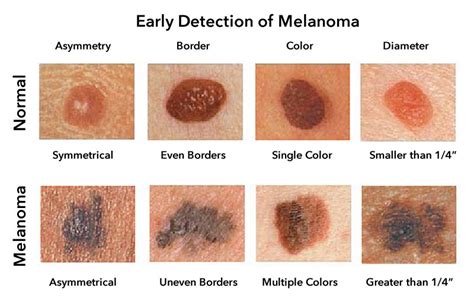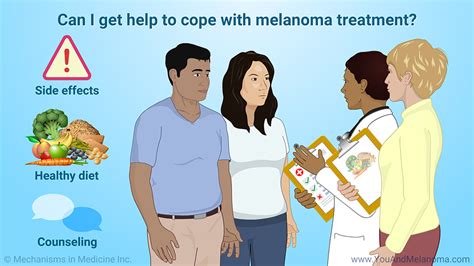Intro
Identify Melanoma Skin Cancer Spots with our expert guide, covering symptoms, warning signs, and types of melanoma, including nodular and superficial spreading melanoma, to aid early detection and treatment.
Melanoma skin cancer is one of the most serious types of skin cancer, and it is essential to be aware of the warning signs to detect it early. The disease occurs when the pigment-producing cells in the skin, known as melanocytes, become cancerous. Melanoma can develop anywhere on the body, but it is most commonly found on the skin that is exposed to the sun, such as the face, arms, and legs. In its early stages, melanoma can be treated successfully, but if left unchecked, it can spread to other parts of the body and become life-threatening.
The importance of recognizing melanoma skin cancer spots cannot be overstated. According to the American Cancer Society, melanoma accounts for only about 1% of skin cancers, but it causes the majority of skin cancer deaths. The key to surviving melanoma is early detection, and this can only be achieved by being aware of the warning signs and taking action if any suspicious spots are found. By understanding the characteristics of melanoma skin cancer spots and taking steps to prevent the disease, individuals can significantly reduce their risk of developing this potentially deadly form of cancer.
Melanoma skin cancer spots can be identified by the ABCDE rule, which stands for Asymmetry, Border, Color, Diameter, and Evolving. This rule is a useful guide for determining whether a mole or spot on the skin is cancerous. If a spot is asymmetrical, has an irregular border, contains multiple colors, is larger in diameter than a pencil eraser, or is changing in size, shape, or color, it could be a sign of melanoma. By being familiar with these characteristics and monitoring the skin regularly, individuals can detect melanoma skin cancer spots early and seek medical attention if necessary.
Understanding Melanoma Skin Cancer

Melanoma skin cancer is a complex disease that is not yet fully understood. However, research has identified several risk factors that increase an individual's likelihood of developing the disease. These include exposure to ultraviolet (UV) radiation from the sun or tanning beds, a family history of melanoma, and the presence of multiple moles or atypical moles. Additionally, individuals with fair skin, blonde or red hair, and light-colored eyes are more susceptible to melanoma. By understanding these risk factors and taking steps to mitigate them, individuals can reduce their risk of developing melanoma skin cancer.
Risk Factors for Melanoma Skin Cancer
The risk factors for melanoma skin cancer can be divided into two categories: genetic and environmental. Genetic risk factors include a family history of melanoma, the presence of multiple moles or atypical moles, and certain genetic mutations. Environmental risk factors include exposure to UV radiation from the sun or tanning beds, as well as a weakened immune system. By being aware of these risk factors and taking steps to reduce exposure to UV radiation, individuals can significantly lower their risk of developing melanoma skin cancer.Prevention and Early Detection

Prevention and early detection are key to surviving melanoma skin cancer. The best way to prevent melanoma is to reduce exposure to UV radiation from the sun and tanning beds. This can be achieved by seeking shade, wearing protective clothing, and applying sunscreen with a Sun Protection Factor (SPF) of at least 30. Additionally, individuals should avoid tanning beds and limit their time in the sun, especially during peak hours. By taking these precautions, individuals can significantly reduce their risk of developing melanoma skin cancer.
Screening and Diagnosis
Screening and diagnosis are critical components of melanoma skin cancer treatment. If a suspicious spot is found, a doctor will perform a biopsy to determine whether it is cancerous. If the spot is found to be melanoma, the doctor will stage the cancer to determine its severity and develop a treatment plan. The stages of melanoma range from stage 0, which is the least severe, to stage IV, which is the most severe. By detecting melanoma early and seeking medical attention, individuals can improve their chances of survival.Treatment Options for Melanoma Skin Cancer

Treatment options for melanoma skin cancer depend on the stage and severity of the disease. In its early stages, melanoma can be treated with surgery to remove the cancerous tissue. If the cancer has spread, treatment may include chemotherapy, radiation therapy, or immunotherapy. In some cases, a combination of these treatments may be used. By understanding the treatment options and seeking medical attention early, individuals can improve their chances of survival.
Types of Melanoma Skin Cancer
There are several types of melanoma skin cancer, each with its own unique characteristics and treatment options. The most common types of melanoma include superficial spreading melanoma, nodular melanoma, and lentigo maligna melanoma. Superficial spreading melanoma is the most common type of melanoma and is characterized by a flat, irregularly shaped spot. Nodular melanoma is a more aggressive type of melanoma that is characterized by a raised, dome-shaped spot. Lentigo maligna melanoma is a type of melanoma that is found on the face and is characterized by a large, irregularly shaped spot.Coping with Melanoma Skin Cancer

Coping with melanoma skin cancer can be challenging, both physically and emotionally. Individuals who have been diagnosed with melanoma may experience anxiety, depression, and fear about the future. However, by seeking support from family, friends, and healthcare professionals, individuals can cope with the emotional and physical challenges of melanoma skin cancer. Additionally, there are many resources available to help individuals understand and manage their disease, including support groups, online forums, and educational materials.
Current Research and Developments
Current research and developments in melanoma skin cancer are focused on improving treatment options and reducing the risk of recurrence. Researchers are exploring new treatments, such as targeted therapy and immunotherapy, and are working to develop more effective screening tools. Additionally, researchers are studying the genetic and environmental factors that contribute to melanoma skin cancer, with the goal of developing more effective prevention strategies. By staying up-to-date with the latest research and developments, individuals can better understand their disease and make informed decisions about their treatment.Conclusion and Next Steps

In conclusion, melanoma skin cancer is a serious disease that requires early detection and treatment. By understanding the risk factors, prevention strategies, and treatment options, individuals can reduce their risk of developing melanoma skin cancer and improve their chances of survival. If you have been diagnosed with melanoma skin cancer, it is essential to seek support from healthcare professionals and to stay up-to-date with the latest research and developments. By working together, we can improve our understanding of melanoma skin cancer and develop more effective treatment options.
What are the symptoms of melanoma skin cancer?
+The symptoms of melanoma skin cancer include a new or changing mole, a spot that is asymmetric, has an irregular border, contains multiple colors, or is larger in diameter than a pencil eraser.
How is melanoma skin cancer diagnosed?
+Melanoma skin cancer is diagnosed with a biopsy, which involves removing a sample of tissue from the suspicious spot and examining it under a microscope.
What are the treatment options for melanoma skin cancer?
+The treatment options for melanoma skin cancer depend on the stage and severity of the disease and may include surgery, chemotherapy, radiation therapy, or immunotherapy.
We hope this article has provided you with a comprehensive understanding of melanoma skin cancer spots. If you have any further questions or concerns, please do not hesitate to reach out to a healthcare professional. Additionally, we encourage you to share this article with others to help raise awareness about melanoma skin cancer and the importance of early detection. By working together, we can improve our understanding of this disease and develop more effective treatment options.
